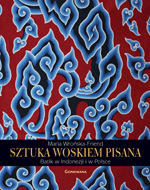
| Strona główna | O firmie | Książki | Kontakt |

|
Art Drawn with Wax: Batik in Indonesia and Poland Maria Wrońska-Friend
|
|
Around 1920, batik – the Javanese technique of wax-resist dyeing, gained enormous popularity in Poland. Fabrics and other objects decorated with the batik technique used to be made by professional artists, among them members of the ‘Cracow Workshops’, as well as by scores of amateurs. Studies of Javanese batiks brought from Indonesia by Polish scientists (Marian Raciborski, Michał Siedlecki) as well as a group of similar fabrics in the famous Oriental art collection of Feliks “Manggha” Jasieński, resulted in the transfer to Polish art numerous principles of Javanese aesthetics, technique and dyeing technology. The ensuing decorative style was frequently described as “Javanese-Cracow”. In recent decades, the activities of the Łucznica Academy art centre has resulted in the revival of this technique. Contemporary Polish batik has evolved into the discipline of fine arts - painting with wax. The technique is practised by numerous artists, as well as having been introduced into fine art education. The book presents the outcomes of research conducted by the author in Indonesia as well as an analysis of collections of textiles in several Polish museums. It has been illustrated with numerous examples of Javanese batiks from the Rudolf G. Smend collection of Cologne, recognised as one of the most significant groups of these textiles in the world. Other examples are from the collections of the National Museums in Cracow and Warsaw, the Ethnographical Museum in Cracow, as well as private collectors. |
|
![[Rozmiar: 21232 bajtów]](batik/okladka4_300_393.gif)
|
Copyright by GONDWANA